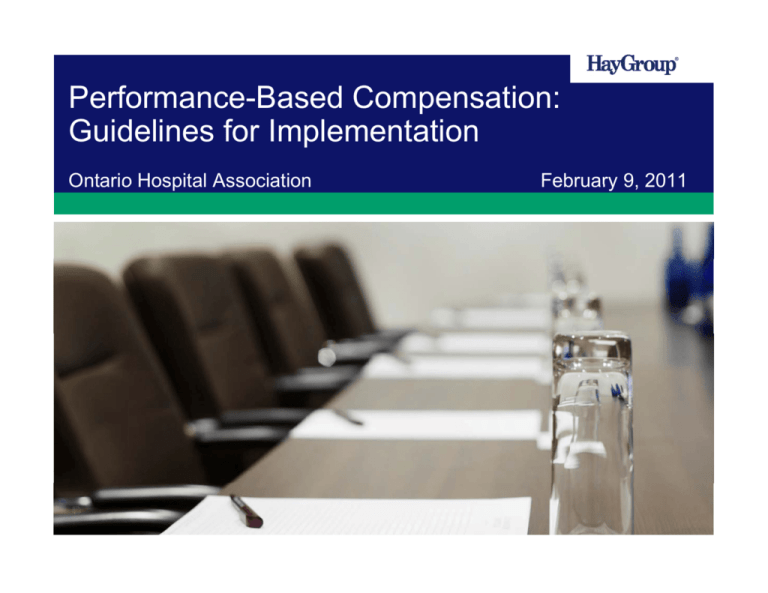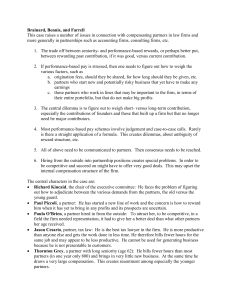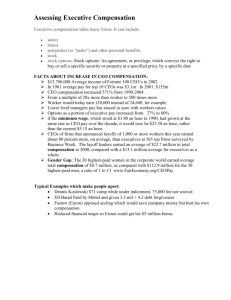
Performance-Based Compensation:
p
Guidelines for Implementation
Ontario Hospital Association
February 9
9, 2011
Agenda
Current Practice in Ontario
Implementation: Short-Term/Long-Term
Six Practical Steps
© 2011 Hay Group Limited. All Rights Reserved
2
Current Practice in Ontario
A minority of Ontario hospitals currently have performance-based
executive compensation plans:
In the 2009 OHA annual salary survey, 25% of hospitals report CEO incentive pay plans
Less than 20 p
per cent for other executives
The larger the organization, the more likely that there is a performance component
Among the very largest hospitals (including academic health science centres) with
annual operating budgets > $500 million,
million about 80% offer incentives; in some cases
cases,
down to the Director level – but these represent less than10% of hospitals
Among larger community and specialty hospitals (budgets of $100 - $500 million),
prevalence drops to about 50% - mostly CEOs and some executives
Among mid-size and smaller hospitals (budgets less than $100 million), prevalence
drops to about 10%
© 2011 Hay Group Limited. All Rights Reserved
3
Current Practice (2)
Amount of performance-based
performance based compensation varies:
The larger the organization, the larger the amount of pay-at-risk
Among the largest organizations:
At the CEO level, the target incentive is generally in the range of 20-30% of base
At the VP level, the range is generally 10-20% of base
Mid-size organizations:
CEO: 10-25%
VP: 5-15%
Small organizations:
CEO: 5-10%
VP: 5%
The above amounts apply
pp y to all performance
p
elements - not jjust quality
q
y
measures
© 2011 Hay Group Limited. All Rights Reserved
4
Why is at-risk pay not more common in
health care?
In the private sector,
sector there is a generally accepted set of performance
measures that are linked to pay
In health care, there is a lack of industry-wide consensus on the key
performance measures– although we are making progress in this direction
Indeed, health care organizations have too many indicators – they have
difficulty identifying a reasonable (small) number that are critical to achieving
organizational strategy
Even when an organization is able to determine the critical indicators, there
is often difficulty determining how these will be measured
Priorities are constantly changing (by government action, in response to
patient needs
needs, etc
etc.)) and there are man
many factors be
beyond
ond the control of health
care executives that make it difficult to agree on and meet targets
© 2011 Hay Group Limited. All Rights Reserved
5
Why is at-risk pay not more common in
health care? (continued)
Many health care organizations do not have rigorous performance
management processes
Managers do not devote enough time to performance management and
coaching (span of control, other priorities)
There is a reluctance to differentiate levels of performance, to differentiate
“high” from “average” performers
The “culture” of health care is generally not aligned with at-risk pay
Hospital executives and managers consider themselves to be
“professionals” who do not need to be incented to do the “right” thing
Performance-based compensation is not an end-in-itself: implementing payat-risk is fundamentally about changing organizational culture
© 2011 Hay Group Limited. All Rights Reserved
6
Implementation
For hospitals that already have performance-based
performance based compensation plans
May require adjustment of metrics to incorporate targets in annual quality
improvement plan
Current plan may not apply to all executives covered by the Act
For hospitals that do not currently have performance-based compensation
plans:
S
Short
-term plan – how do we ensure compliance as off April 1, 2011
Long-term plan – what are our long-term goals for performance-based
compensation
© 2011 Hay Group Limited. All Rights Reserved
7
Short-Term:
Short
Term: Six Practical Steps
1. Confirm responsibilities
2. Determine the purpose of the plan
3. Decide on the amount of pay-at-risk
4 Determine
4.
D
i the
h performance
f
targets
5. Determine the design of the pay-out structure
6. Evaluate the plan and prepare for Year 2/Long-term implications
© 2011 Hay Group Limited. All Rights Reserved
8
1 Responsibilities
1.
Who is responsible for establishing and approving the executive performanceperformance
based compensation plan?
Reference your Executive Compensation Policy
The plan should be “designed”
designed by a Committee (e.g.,
(e g Compensation
Committee, Executive Committee) in consultation with CEO/Chief of Staff
Assistance provided by HR (recognizing that there is a conflict)
The CEO
C O and Chief
C f off Staff
S ff plan should be approved by the Board
The “VP plan” may not have to be approved by the Board, but it is probably a
good idea to obtain approval – especially for the design of the plan
Implementation by CEO based on approved plan design
© 2011 Hay Group Limited. All Rights Reserved
9
2 Purpose of the Plan
2.
The purpose of the plan should inform the design
Determine the purpose/objectives of the plan
Compliance?
C
Controlling
lli compensation
i costs?
?
Focusing the attention of the executive team on key priorities?
© 2011 Hay Group Limited. All Rights Reserved
10
3 Amount of Pay-at-Risk
3.
Pay at Risk
Considerations should include:
Legal requirements
There are no specific requirements concerning the amount of performancebased compensation
Market practice
Fairness to incumbents; need to maintain morale/focus; retention
Purpose of plan – if a major purpose is to focus attention of executives,
amount should be sufficient to do this: a small amount (1 or 2 %) is unlikely to
incent performance
Reasonableness: a minimum of five per cent linked to quality targets
In future years, higher amounts could be phased in
Public reporting
© 2011 Hay Group Limited. All Rights Reserved
11
4 Performance Targets
4.
The performance targets must be part of the QIP - there are no other specific
requirements concerning the type or number of targets
A performance-based compensation plan should contain no more than 5-10
performance targets (including both quality and other targets)
If there are more, focus is diluted and the dollar value of any single measure
becomes too small to influence behaviour
One of the biggest challenges in health care is to identify a small (reasonable)
number
b off goals
l or kkey performance
f
measures and
d tto establish
t bli h metrics
ti
Targets should reflect the strategy and key priorities of the organization
In ensuing years, additional targets could be introduced, including individual
and
d tteam targets
t
t
The target should be challenging, but not too “stretch”
It should “raise the performance bar”
It should
h ld b
be achievable,
hi
bl b
butt nott easily
il achievable
hi
bl
If the target is set too high, it can be de-motivating
© 2011 Hay Group Limited. All Rights Reserved
12
5 Design of Pay-Out
5.
Pay Out Structure
What should participants earn if performance is above or below target?
“All or nothing” – this may be appropriate for some measures, but generally
not recommended as inability to reach target may create performance
disincentive
We typically recommend a performance “corridor”:
Performance Level
Definition
Threshold
Minimum level of performance that must be achieved in
order to earn a pay-out
Target
Targeted/desired level of performance; in public sector
plans, this is often the maximum pay-out
pay out
Partial pay-out
Range between Threshold and Target in which there is a
partial pay-out based on performance achievement
Maximum
Level for outstanding performance; pays out at above target
level; pay-out occurs between target and maximum
© 2011 Hay Group Limited. All Rights Reserved
13
5 Design of Pay-Out
5.
Pay Out Structure (2)
Other considerations include:
Relative weighting of individual performance targets
Weighting of corporate/divisional/individual targets
© 2011 Hay Group Limited. All Rights Reserved
14
6. Evaluate the Plan and Prepare for
Year 2/Long
2/Long-Term
Term Plan
Were the plan objectives achieved?
Compliance
Control of compensation costs
Focus attention
Other
Consider amount of pay-at-risk
Consider whether new quality measures should be introduced, and/or existing
measures modified/re-calibrated
Consider adding
g other performance measures ((e.g.,
g balanced scorecard))
Consider weightings of performance measures
Consider extending plan to other positions/levels in organization
© 2011 Hay Group Limited. All Rights Reserved
15







